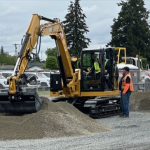The positive impact of the construction industry on local economies
The construction industry plays a pivotal role in the growth and development of local economies worldwide. Beyond just building structures, it serves as a cornerstone for economic prosperity, job creation and community development. In this blog, we will delve into the numerous ways in which the construction industry positively influences local economies, bringing about a wide range of benefits for everyone involved.
serves as a cornerstone for economic prosperity, job creation and community development. In this blog, we will delve into the numerous ways in which the construction industry positively influences local economies, bringing about a wide range of benefits for everyone involved.
Job creation
One of the most significant contributions of the construction industry to local economies is job creation. Construction projects, whether residential, commercial or infrastructure-related, require a diverse workforce. From skilled tradespeople like carpenters, electricians and plumbers to engineers, project managers and administrative staff, the industry offers a wide array of rewarding career opportunities.
These jobs provide stable income for countless families and individuals, reducing unemployment rates and stimulating consumer spending within the local community. As construction projects progress, the demand for labor grows, and this upward trend in employment is a boon for the local economy.
Income generation
A thriving construction sector leads to higher incomes for a wide range of stakeholders. Construction workers earn competitive wages, and those with specialized skills often command even higher pay. This results in increased disposable income, which is essential for local businesses, as residents have more money to spend on goods and services.
Local businesses, from restaurants to retailers, benefit from the influx of construction workers and the increased spending power of the community. The multiplier effect of this economic activity amplifies the positive impact, as income generated in one sector flows through the local economy, benefiting numerous businesses in the process.
Tax revenue
The construction industry contributes significantly to local tax revenue. When construction projects are undertaken, various taxes are generated, including property taxes, sales taxes, and income taxes. These revenues support public services such as schools, healthcare, and infrastructure maintenance.
Furthermore, construction activities often require permits and licensing fees, which add to the municipal coffers. The tax revenue generated by the construction industry is a vital source of funding for local governments, enabling them to invest in community development projects and public services.
Infrastructure development
An active construction industry leads to the development and improvement of local infrastructure. Roads, bridges, public transportation systems, and utilities all require continuous maintenance and upgrades. The construction sector plays a crucial role in these efforts, which not only enhance the quality of life for residents but also contribute to economic growth.
Better infrastructure attracts businesses to the area, creating more jobs and opportunities. It also improves the overall attractiveness of the community to residents and potential investors, leading to increased property values and economic stability.
Supplier and support services
The construction industry relies on a network of suppliers and support services that further stimulate the local economy. Suppliers of construction materials, equipment, and machinery often have a significant presence in the area, creating jobs and generating economic activity. Additionally, construction projects require services such as engineering, architecture, legal, accounting, and marketing, all of which contribute to the local service sector.
Community development
Beyond the immediate economic benefits, the construction industry also contributes to community development. Many construction projects include provisions for affordable housing, community centers, parks, and other amenities that enhance the overall quality of life. These developments create vibrant and thriving communities, attracting residents and businesses alike.
In conclusion, the construction industry is a powerhouse for local economies, offering a multitude of benefits that extend far beyond the physical structures it creates. Job creation, income generation, tax revenue, infrastructure development, supplier and support services, and community development all contribute to the growth and prosperity of the local community.
As the construction industry continues to evolve and innovate, its positive impact on local economies remains steadfast. It serves as a catalyst for economic growth, job opportunities, and enhanced quality of life for residents, making it a vital component of any thriving community.








